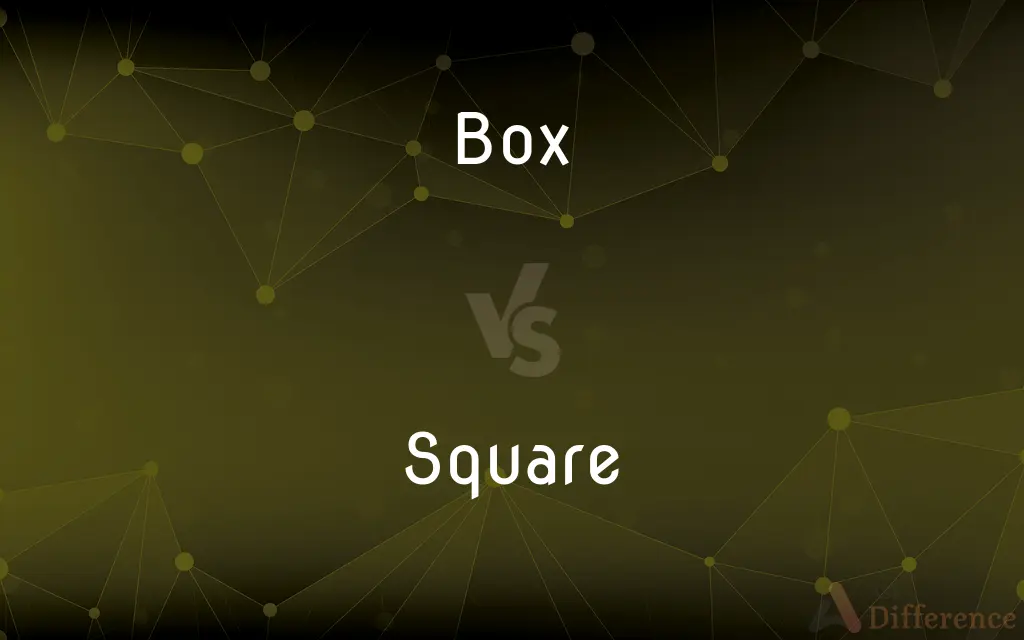Box vs. Square — What's the Difference?
By Fiza Rafique & Maham Liaqat — Updated on February 22, 2024
A box is a three-dimensional object with volume, often used for storage or containment, whereas a square is a two-dimensional shape with four equal sides and right angles, purely a geometric concept.

Difference Between Box and Square
Table of Contents
ADVERTISEMENT
Key Differences
A box, in its most common understanding, is a three-dimensional container with length, width, and height, used for storing, transporting, or containing items. Boxes can be made from various materials, including cardboard, wood, plastic, or metal, and are designed to protect and organize contents. They come in various shapes, but the most typical box is rectangular, sometimes approximating a cube if all dimensions are equal.
A square, on the other hand, is a flat, two-dimensional figure defined by four equal-length sides and four right angles. It is a specific type of rectangle and a special case of a parallelogram. In geometry, a square is purely abstract and does not have volume or thickness. Squares are used in various mathematical and design contexts, symbolizing equality, symmetry, and regularity.
A square is a geometric concept without physical substance, whereas a box is a tangible object utilized in everyday life. The comparison between a box and a square often arises in discussions about shapes and dimensions, particularly when explaining the difference between 2D and 3D objects. For instance, the face of a box might be square if all its edges are equal, but the box itself extends into the third dimension with depth.
The concept of a square is fundamental in geometry and is often used to teach principles of symmetry, area calculation, and properties of angles. In contrast, boxes are practical objects encountered in various contexts, from packaging and shipping to storage and organization.
Understanding the difference between a box (a 3D object with utility and volume) and a square (a 2D geometric shape with equal sides and angles) is crucial in fields ranging from mathematics and design to logistics and everyday organization. This distinction helps in accurately describing objects, solving geometric problems, and applying appropriate terms in various professional and educational contexts.
ADVERTISEMENT
Comparison Chart
Dimensions
Three-dimensional (3D) with length, width, and height.
Two-dimensional (2D) with length and width only.
Purpose
Used for storage, transportation, or containment of items.
Purely a geometric shape used in mathematical and design contexts.
Properties
Can vary in shape, but typically has six faces, with the rectangular box being the most common.
Has four equal-length sides and four right angles.
Materiality
Made from materials like cardboard, wood, plastic, or metal.
An abstract concept without physical form.
Application
Practical use in everyday life for organizing, protecting, and containing objects.
Used to teach geometric principles, calculate area, and design symmetric structures.
Compare with Definitions
Box
Three-dimensional container.
She packed her books into a cardboard box.
Square
Four-sided equal-length shape.
The child drew a perfect square on the paper.
Box
Protective container for transport.
Fragile items were secured in a sturdy plastic box.
Square
Basis for grid layouts.
The city's streets were arranged in a square grid.
Box
Storage object with volume.
The wooden box held all the vintage photographs.
Square
Geometric figure in mathematics.
Calculating the area of a square involves squaring the length of one side.
Box
Cuboidal item for organization.
He used small boxes to organize the workshop tools.
Square
2D shape with right angles.
The tiles were laid out in a square pattern.
Box
Packaging form.
The product came in an attractively designed box.
Square
Symbol of symmetry.
The square design emphasized balance and uniformity.
Box
A box (plural: boxes) is a type of container or rectangular prism used for the storage or transportation of its contents. The size of a box may vary, from the very smallest (such as a matchbox) to the size of a large appliance, and can be used for a variety of purposes ranging from the functional to the decorative.
Square
The relation of harmony, or exact agreement; equality; level.
Box
A container with a flat base and sides, typically square or rectangular and having a lid.
A hat box.
A cigarette box.
Square
In geometry, a square is a regular quadrilateral, which means that it has four equal sides and four equal angles (90-degree angles, or 100-gradian angles or right angles). It can also be defined as a rectangle in which two adjacent sides have equal length.
Square
Having four equal sides and four right angles; as, a square figure.
Square
The position of planets distant ninety degrees from each other; a quadrate.
Square
To compare with, or reduce to, any given measure or standard.
Common Curiosities
What is the primary use of a square in geometry?
In geometry, a square is used to study properties of shapes, symmetry, area calculation, and principles of angles.
Can a square exist in three dimensions?
A square itself cannot; however, a 3D version of a square is a cube, where all faces are square.
How do you differentiate a square box from other boxes?
A square box has square faces (all sides equal), but it's distinguished from other boxes by its depth, making it three-dimensional.
How does the material of a box affect its use?
The material determines the box's durability, protective qualities, and suitability for specific contents (e.g., cardboard for lightweight items, metal for valuables).
Can a box be square?
Yes, the face of a box can be square if all sides are equal, but the box itself is still a 3D object.
Can boxes have shapes other than rectangular or square?
Yes, boxes can come in various shapes, including cylindrical, hexagonal, and more, although rectangular boxes are most common.
How does the thickness of a square's line affect its properties?
In practical applications, line thickness doesn't affect the square's geometric properties, but it can influence visual perception and design elements.
Are all squares the same size?
Squares can vary in size, but all sides must be of equal length.
Is a square always flat?
Yes, a square is a two-dimensional shape with no volume, making it always flat.
What makes a square different from other quadrilaterals?
A square has four equal sides and four right angles, distinguishing it from other quadrilaterals, which may not have equal sides or right angles.
Is the concept of a square used outside of mathematics?
Yes, the square shape is used in design, architecture, art, and various planning contexts due to its symmetry and simplicity.
Why are boxes important in logistics and shipping?
Boxes protect contents, maximize space, and facilitate easy handling and stacking during transport.
What role do squares play in urban planning?
Squares help in designing city layouts, ensuring uniformity and ease of navigation with their equal sides and symmetrical properties.
What geometric principles can be learned from a square?
Principles such as symmetry, congruence, the Pythagorean theorem, and area calculation are associated with squares.
How is the volume of a box calculated?
The volume is calculated by multiplying the box's length, width, and height.
Share Your Discovery

Previous Comparison
Bird vs. Chick
Next Comparison
Boy vs. GirlAuthor Spotlight
Written by
Fiza RafiqueFiza Rafique is a skilled content writer at AskDifference.com, where she meticulously refines and enhances written pieces. Drawing from her vast editorial expertise, Fiza ensures clarity, accuracy, and precision in every article. Passionate about language, she continually seeks to elevate the quality of content for readers worldwide.
Co-written by
Maham Liaqat













































